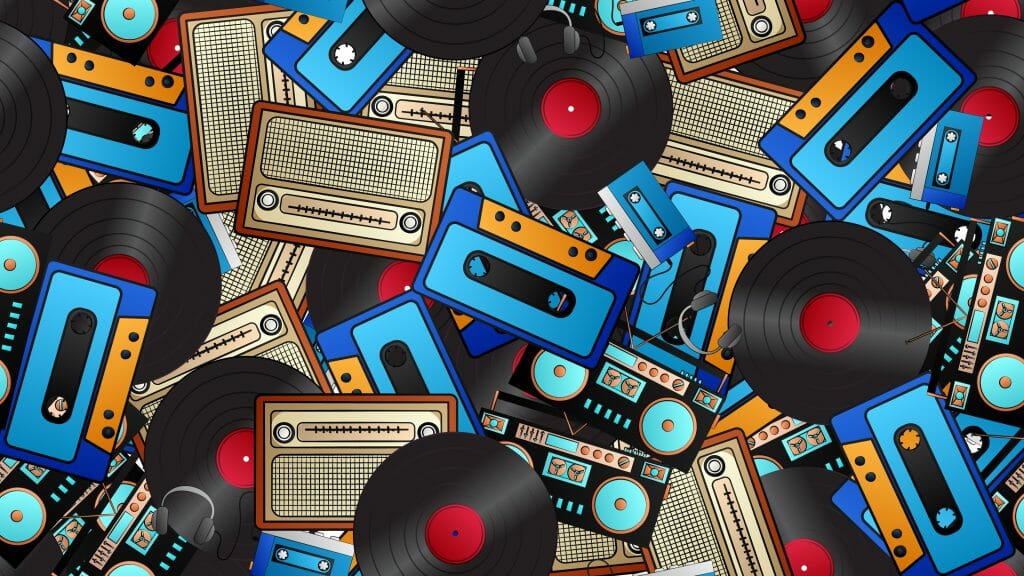The aesthetics of the Y2K-era have seen a major resurgence in recent years, especially in the world of electronic music — here are four artists to check out when you want your Y2K fix with a modern twist.
Although they might know it by names like “Toonami-core” or “Toonami-type beats,” Gen Z is spearheading a new wave of drum and bass, a genre of electronic music known for its impossibly fast, skittering breakbeats and icy textures. But zoomers’ obsession with drum and bass is part of a larger trend toward other styles of electronic music from the late ‘90s and the early 2000s, and toward the aesthetics of the Y2K-era in general.
After becoming interested in understanding the ‘futuristic look’ he remembered from his childhood, architect, and design archivist Evan Collins began researching media from the period as early as 2014, terming it the ‘Y2K Aesthetic’. Two years later, he started the Y2K Aesthetic Institute, a Tumblr page that documents the era’s gaudy colors, smooth-flowing curves, futuristic imagery, and technological utopianism.
Collins attributes Gen Z’s revival of the Y2K aesthetic to several different factors. For one, people tend to develop an interest in the time before they were born, which has fueled many aesthetic revivals of the past. It’s also common for people living through stressful times to look to the past for solace — and, with their formative years shaped by climate change, economic uncertainty, and the pandemic, Gen Z is plenty familiar with stress. Thus, the sunny, carefree idealism of the Y2K era is particularly appealing. Finally, there’s an element of backlash to it, as the Y2K aesthetic stands in exuberant opposition to the general 2010s’ trend towards minimalism.
But Collins has found that Gen Z imbues Y2K sounds and visuals with their own absurdist sensibility, pushing the aesthetic forward rather than lazily recycling it. “Something new has been done to it each time,” he said. “There’s a lot of influence from ‘extremely online,’ weird internet culture and emerging styles like Blob World, Psychedelia-revivals, etc., and it can expand because it’s infused with new graphics, animation, and video technologies.”
As the experiential marketing manager for Youth Marketing Connection (YMC), a millennial/Gen Z marketing agency, Spenser Wempe has to stay informed on the constantly-shifting youth trends of the digital age. She first noticed Gen Z’s affinity for the Y2K aesthetic on social media, and soon found it playing a role in her marketing work. For example, YMC is currently tasked with marketing Samsung’s foldable smartphones, reminiscent of Y2K flip phone technology. Gen Z’s penchant for maximalism informs subtler aspects of the marketing process as well, like selecting which colors to use for an advertisement.
“We saw a lot of neutral tones and palettes being popular when we were focusing on millennial consumers,” Wempe said. “[For Gen Z] we’re really thinking about colors and ways that we can bring their playfulness into a color palette.”
Maximalism, playfulness, embracement of technology — the variegated EDM subcultures of the Y2K era (including drum and bass, hardcore techno, and trance) embody all these. Zoomers aren’t merely carrying the torch — they’re taking it in entirely new directions, gleefully fusing disparate genres and staying true to the scattered sensibilities of their generation, all while maintaining a relationship with the past.
Here are four young artists indebted to Y2K electronic music that you need to know.
1. Kaizo Slumber
Effortlessly shifting between chaos and serenity, hardcore rave-up and shimmering ambiance, gritty distortion and dreamy, Y2K gloss (often within the same song), Kaizo Slumber is tough to pigeonhole — so tough, in fact, that Kaizo Ziad, the Libyan-German producer behind the project, had to coin a term of his own to describe it. He calls his music “slumberkei,” kei being the Japanese word for “style,” because “the -core suffix is played out.”
Video games loom large in the world of slumberkei. Ziad’s synth textures, melodies and album art often recall the aesthetics of retro Nintendo games, from the N64 era up to the Wii. He developed an interest in this period of gaming mostly because he had no other choice.
“I lived in Libya and Lebanon for a lot of my life, and internet speeds were godawful,” he said. “Getting the newest games was very difficult…so a lot of the games I discovered during that time were retro games that I could easily emulate on my crappy laptop, or bootleg games from the local DVD store.”
But Ziad doesn’t merely mimic these games — instead, he pulls from them directly, taking sounds from their MIDI files and using them as instrumentation. The resulting music, while difficult to categorize, feels eerily familiar, maybe even a little cozy. Ziad’s next album will be his noisiest yet, a blur of fast, punchy songs inspired by punk and digital hardcore.
One of the most crucial aspects of slumberkei is that it’s never insincere, instead embracing the utopianism of the Y2K-era without a lick of irony. “[My music] embraces, with full sincerity, the bright, happy aesthetics of the late ‘90s and early 2000’s…Kaizo Slumber is supposed to be a beacon of light.”
2. Evaboy
Sentimentalists everywhere have mourned the death of local music scenes at the hands of the internet, but Miya Lowe doesn’t seem to mind. “I wouldn’t be able to make the music I make if I if there was no Internet, and there was [only] a regional scene,” the NorCal-based producer said. “I’d be doing Metallica covers, because that’s the scene here. Where I live, it’s Brockhampton clones and Metallica cover bands, so I’m glad that the internet’s a thing.”
And indeed, much of Lowe’s music could only come from the internet — their 2019 album Chao Gardens, released under the Evaboy moniker, features night core-inflected drum and bass remixes of songs by the likes of Yung Lean and Drake, with Y2K-inspired Sonic the Hedgehog cover art for good measure. It’s tempting to rationalize this tossing together of various elements as some sort of ironic gesture, but really, Lowe just channels the things he likes — it feels frenetic and overwhelming simply because that’s the cultural landscape he grew up in.
While Lowe has moved away from these stylings in recent years (“It’s very dated,” they said. “I know I have better musical abilities than just speeding other people’s shit up.”), the Y2K era remains a major part of their DNA. Their upcoming album pays homage to regional American club music, like Miami bass and New Orleans bounce, along with the lusty, sinuous R&B of the 2000s.
As for Gen Z’s rediscovery of drum and bass and similar genres, Lowe chalks this up not just to the democratizing power of the internet, but also to the music’s ability to resonate with alienated, terminally online young people in particular. “Loud music is interesting to teenagers who have untreated issues, and I’m not saying that like it’s an insult,” he said. “It’s very marketable to them. And I know that, because that was me.”
3. Nanoray
Nanoray grew up in a traditional, Christian household in Omaha, Nebraska — not exactly a hotbed for the sweaty, subterranean rave scenes of the ‘90s. Thus, his music is partially an effort to recapture this moment he feels he missed out on. “I’m sort of visiting the stuff that I never got to experience,” he said. “It’s very exciting and colorful, and it’s interesting to be a part of that after the fact.”
But Nanoray puts his own spin on the past, often blending several genres of electronic music over the course of a single album — drum and bass, breakbeat hardcore, and other traces from the Y2K era all swirl around in a miasma of pummeling, visceral kicks, and crystalline synth lines. His most recent album, 2022’s TOYBOX, was largely inspired by DJ Technorch, a Japanese producer known for his deranged, freeform approach to hardcore.
Before releasing music, Nanoray planned on going to school for animation. This fell through, leading him to work various jobs while creating his own video game on the side. He drew on childhood piano lessons to compose original music for the game, allowing him to gain experience in FL Studio and eventually focus on music entirely. Video games remain a major source of inspiration, with his album art, redolent of the first PlayStation, being just one example.
While Nanoray is pleased with the renewed interest in drum and bass and similar genres, he considers the phrase “drum and bass revival” a bit of a misnomer. “Instead of it being revived, I think people are just rediscovering it,” he said. ” These artists have been around forever…I don’t think it’s a revival. I don’t think it ever died in the first place.”
4. Glacci
For all its experimental qualities, Glacci’s music is dripping with hooks — walloping kicks, euphoric vocal samples, and neon-drenched synth lines irresistible to anyone with functioning ears and one or two serotonin receptors still left. “I really enjoy pop music a lot,” said Kyle Cook, the producer behind the Glacci moniker. “I’ve always been intrigued having just a bunch of weird sounds, but then having a really strong hook or melody along with those.”
Cook was too young to experience the U.K. club underground of the ‘90s and 2000s, but he takes plenty of inspiration from its generous, optimistic spirit. Fun, fun, fun reigns supreme on Glacci’s iridescent, candy-coated dancefloor. “It seems like everybody was there to have fun, no matter who you were,” he said. “[I] see things through rose-tinted glasses a bit, because everything is just so wonderful to you when you’re a kid. But I think there’s something still particularly special about that time.”
In addition to releasing his own music, Cook also releases projects by other electronic artists under his imprint/collective, Moonbeams, which he runs with two friends. He founded Moonbeams to provide a home for himself and like-minded artists, as other electronic labels, many of which lean toward a darker, more lo-fi sound, didn’t resonate with him.
Cook performs live throughout the U.K. With attendees often varying in age, he’s found that his intoxicating, Y2K-inspired music cuts across generational lines. “There are a lot of young people, along with people in their 30s or 40s who might have liked this kind of music years ago,” he said. “It’s nice to have just anyone come through.”






